Joint Ops: Why Minnesota has two pro-marijuana parties
Minnesota taxpayers might have wondered, while gazing at the State Election Campaign Fund portion of form M1, why there are two political parties dedicated to marijuana legalization. Is there some subset of beliefs that divide the parties to the point where they can’t work together? Does one party want cannabis legalized in a different way than the other?
The answer is neither.
According to party leaders, the Grassroots-Legalize Cannabis Party and Legal Marijuana Now Party are basically the same thing — two different brands with a single message, two separate entities obtaining campaign funding for the same goal.
At their inceptions, neither party deployed the words “marijuana” or “cannabis” in their names, but added the terms later when it was deemed helpful to the movement.
Oliver Steinberg, treasurer of the Grassroots-Legalize Cannabis Party, remembers discussing the matter with future presidential candidate Dan Vacek in the late 1990s.
“At which point Mr. Vacek says ‘You know, all we have to do is put it right there on the ballot, call it the Legal Marijuana Now Party and then every vote we get will be a referendum. Every vote we get will be indisputable evidence that there’s a voter that wants legal marijuana.’ So that was the emphasis for trying out the Legal Marijuana Now Party.”
The Grassroots Party of Minnesota formed in 1986 and spun off an additional party in 1996 — the Independent Grassroots Party — which became the Legal Marijuana Now Party in 1998. The Grassroots Party changed its name to Grassroots-Legalize Cannabis Party in 2014. Both have remained at the forefront of the movement to legalize cannabis in the state.
“That was sort of an experiment, branching off from the Grassroots Party,” said Vacek, who ran for President of the United States in 2016 for the Legal Marijuana Now Party. “I think it was primarily a discussion about what name is the best and it turned out that we succeeded in getting two parties out of the deal.”
Minnesota’s major parties — Republican and Democratic-Farmer-Labor — are distinguished from minor parties by two basic characteristics: running more candidates and getting more votes. The state has five minor parties — Independence, Grassroots-Legalize Cannabis, Green, Libertarian and Legal Marijuana Now. The threshold for achieving minor party status is multifaceted, according to the 2018 Minnesota Campaign Manuel, but the basic requirement is consistently running at least one candidate who receives votes “in each county that in the aggregate equal at least one percent of the total number of individuals who voted in the election.”
Taxpayers have the option when filing to select a major or minor party and direct the state to contribute $5 to it through the State Elections Campaign Fund (via individual income tax form M1). They can also utilize the Political Contribution Refund program (form PCR) to contribute gifts of money to candidates for state office or to a state political party and apply for a maximum refund of $50 for an individual or $100 for a married couple.
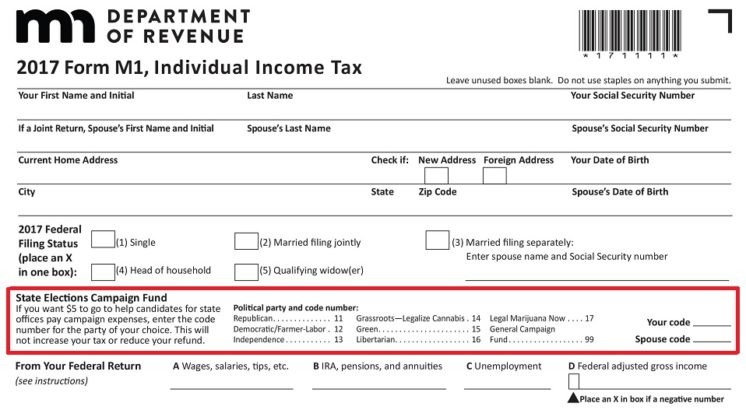
Minnesota income and property tax-return forms have a section where taxpayers can check a box instructing the state to designate $5 from the general treasury fund to a selected political party’s State Elections Campaign Fund.
The amount pulled in through the checkoff program is meager. It totalled $736,170 in 2015, according to the State of Minnesota Campaign Finance & Public Disclosure Board 2015-2016 Campaign Finance Summary. There is also a trend of fewer Minnesotans opting to check the box on their tax form. In 1987 the state increased the amount donated through each checkoff from $2 to $5 and the total amount received doubled to $1.8 million. Since then the number of contributions has dropped to the point where the amount collected is virtually the same — roughly $700,000 — as it was in 1986.
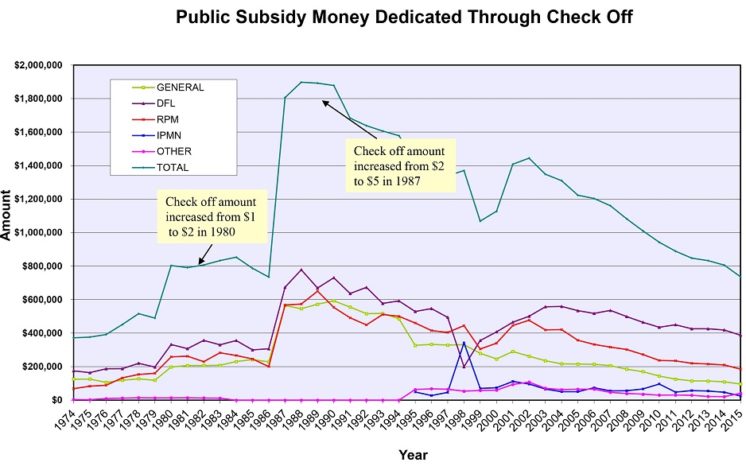
Source: State of Minnesota Campaign Finance & Public Disclosure Board 2015-2016 Campaign Finance Summary
Ten percent of the amount designated on a state income or property tax return for a political party is paid to the state central committee of that party. The list below shows both pro-marijuana parties collected less than $1,000 each in 2016.
2016 Public Subsidy Received
$38,905 – Democratic-Farmer-Labor
$18,376 – Republican
$2,684 – Independence
$1,480 – Green
$947 – Legal Marijuana Now
$931 – Libertarian
$658 – Grassroots-Legalize Cannabis
The money brought in by parties through the Political Contribution Refund program is a bit more substantial. A total of $2,162,062 in public subsidy was distributed to state senate and house of representatives candidates for the 2016 election, but the two pro-marijuana parties did not run candidates in those races.
“Some days it’s more of an idea than an organization,” Steinberg said of the Grassroots-Legalize Cannabis Party. “We’re not what people think of in terms of a political party, it’s more of an ad-hoc kind of approach. We don’t have enormous resources of money and big legions of volunteers.”
According to Vacek there are activists who have joint membership in both parties. Legal Marijuana Now intends to run Dennis Schuller for U.S. Senate and Chris Wright for Minnesota Governor in the upcoming election. The goal is not necessarily to win, but to get enough votes for the marijuana legalization issue to not be ignored. Vacek thinks the movement is growing and it might be time to expand again.
“The time has come for this change to happen,” he said. “I’ve thrown the idea out of trying a couple more new names this year and having three or four official parties next year. One of the names we’re floating is End Cannabis Prohibition Party.”
Minnesota Secretary of State Steve Simon thinks it’s good for political parties to work together to achieve what they want done.
“There is a long tradition in Minnesota of like-minded political parties coming together to make change,” said Simon. “The DFL itself is the result of two parties in 1944, the Minnesota Democratic Party and the Minnesota Farmer-Labor Party, joining together around shared values to create a more effective party.”
Vacek says there are advantages to having two parties working for the same goal.
“I call it product placement, being on the tax form in two places is a point of sale,” he said. “We get twice as much public funding when we are on there twice.”
But progress on marijuana legalization does not seem to be in the near future. Vacek said the outcome of this fall’s election will guide the timeline.
“If we get a Republican governor then it can be decades off,” he said. But action could come sooner if the governorship and Minnesota House swing Democratic.
Vacek said even if the 2018 election goes the way he wants, the Minnesota Legislature is not likely to put marijuana legalization on the ballot in 2020 because it’s a presidential election year. The goal is to get it on the ballot in 2022, but Vacek says even that is an optimistic outlook.
Steinberg notes that if victory ever comes it won’t end up boosting the status of the pro-pot parties.
“The idea of the Grassroots Party is to basically put ourselves out of business,” he said.
Recommended Links:
Leave a Comment
Only registered members can post a comment , Login / Register Here


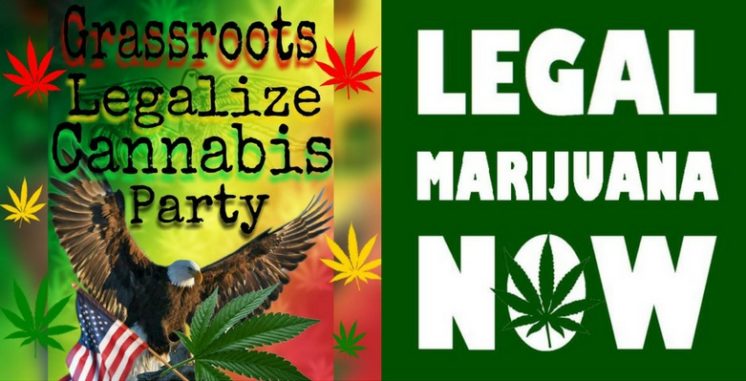
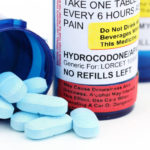


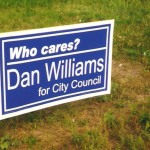








No Comments